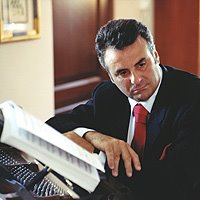Marcello Giordani - You build your career by saying no many times.

Q and A: Marcello Giordani on Minghella, Masterclasses and Vocal Crisis
By Vivien Schweitzer
September 25, 2006
The Metropolitan Opera's new production of Puccini's Madama Butterfly, directed by Oscar-winning filmmaker Anthony Minghella (doing his first opera), is the hot ticket of the fall season in New York. Forty-three year old tenor Marcello Giordani stars as Lt. Pinkerton, one of four roles he will sing at the Met this season.
Recently Giordani spoke with PlaybillArts about working with a film director, the lessons he learned from his vocal crisis in the early '90s and his upcoming masterclass at the Manhattan School of Music.
How is it different working with a film director rather than an opera director?
[Anthony Minghella] loves opera and he respects the singers and the music, but his perspective is different than a regular opera director because he is used to working with cameras. In general, we singers anticipate the mood with our facial expressions; we comment with our faces and our eyes. But Minghella wants it to be less artificial and more spontaneous. Sometimes he says, "Just think and listen to your colleagues and that will be enough."
I asked him to be hard on me and to interrupt me if I did something wrong. And he does. It makes me more interested in the work.
I have really learned a lot working with Minghella, who is brilliant. I have done many Butterflys, but this time I had to be open-minded, willing to listen and take advice. It's like I'm singing Pinkerton for the first time.
Minghella is a very gentle and kind person and he likes it if you ask questions, because he is always trying to help make everything smooth and comfortable for all the singers. I have enjoyed this production of Butterfly more than most!
You're giving your first masterclass in November at the Manhattan School of Music. What advice do you give to young singers?
I am nervous about my first masterclass, as I'd rather sing than speak! But it will be fine. I am thrilled to share my experiences with young singers. People have always been pushing young artists, but I advise them to be patient. You build your career by saying no many times.
The really important thing is to think long-term. I've seen so many young singers be hot for five years, then disappear. It can be the fault of opera houses, publicists, bad advisors or managers. For me, the best friend is the one who says "You were so bad on stage," not the friend who always says "you were great." It's more loyal to be honest.
In 1994, after you were fired from Rigoletto at La Scala, you took a sabbatical and retrained with New York vocal coach William Schuman. How did that help you?
It gave me confidence; I was really sick mentally. I was taught that singing was like a hidden science, that you have to fight for every single note. What Schuman did was reopen my mind and give me my self-confidence back. He knows my voice better than me. Once in a while you have to bring your car to the mechanic and let him fix it.
I have felt more secure in the last five to seven years. From 1994-99 I still was a work in progress; I think now my voice has evened out. Before, I had two kinds of voices. The top was there, but Schuman trained me to build the middle as well, which is the fundamental. Otherwise the building crashes all the time.
Did the vocal crisis make you much more cautious about which roles you sing?
Yes, of course. I am always saying no, but I can't tell you which roles I've recently turned down! But before I say no, I think carefully and look at the score. Then I decide whether my voice is suitable, regardless of whether it's a bel canto or a heavier role. I try out the role for a couple months, and if at the end I'm tired, it means it's not right. Perhaps it stretches my voice too high or too low — both good signs indicating I'm not ready for the role. Sometimes you fear the opportunity won't come again, but if you say yes before you're ready technically or mentally, you have to be prepared to lose your vocal and mental health.
What caused the cancellation of your recital this past August with the Opera Orchestra of New York?
The recital was cancelled because I didn't agree with their marketing. But they cancelled it, not me. People were saying maybe I cancelled it because of money, but I didn't have a signed contract with them. It was nothing to do with money. I do enjoy recitals, because I have more connection with the audience when they are very close and I can choose which repertoire I want to sing. I like to be myself and not be hidden behind the costumes.


